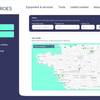Having already completed two years of service supporting the operations of the US Marine Corps’ Third Marine Expeditionary Force (III MEF) in the Western Pacific theatre, the Austal catamaran “WestPac Express” has become the first large high speed vessel (HSV) to be registered and flagged as a commercial ship in the United States.
After a competitive bid process, the HSV was first chartered in July 2001 for a “proof of concept” period. This was so successful that the Military Sealift Command signed a three year charter in January 2002, again after receiving several competing offers. The III MEF charter was the first time the US military had contracted a commercial vessel of this type for military support.
A requirement of the contract was that the vessel be re-flagged to the United States, a demanding process that has been achieved within the ship’s normal maintenance periods and was managed by Austal Service. Jim Black, Austal Service Manager, explained that in order to obtain the US flag, every aspect of the ship’s design and construction was rigorously examined by the United States Coast Guard Marine Safety Center in Washington, DC. The ship was subsequently inspected by Officer-in-Charge, Marine Inspection (OCMI) personnel from USCG Far East Activities (FEACT) based in Tokyo to ensure compliance with the applicable flag state requirements.
“The USCG had never previously surveyed a lightweight, high-speed vehicle-carrying vessel before and to its credit was extremely thorough in its approach. For example, every one of the ship’s drawings were scrutinised in detail and on numerous occasions it was necessary for Austal to justify certain aspects to the USCG, even though the ship is classed by one of the world’s leading classification societies and built to the IMO’s HSC Code,” Mr Black said.
“This reflects the high degree of professionalism in the USCG and highlights that meeting US flag requirements for this type of vessel is not the simple process that some may think. Certainly it would be challenging for organisations that do not have the depth of high speed vessel experience and professional engineering expertise that exists within the Austal group,” he added.
The new port of registry for “WestPac Express” is Mobile, Alabama where Austal has a modern shipyard that specialises in the construction of high performance aluminium vessels. A joint venture with Bender Shipbuilding and Repair, Austal USA brings Austal’s world-leading aluminium ship design and manufacturing capabilities to the United States’ commercial and military vessel markets.
Austal USA has already completed six commercial vessels, ranging in size from 25 to 43 metres and is currently building a 58 metre fast passenger-vehicle catamaran. On the military front, Austal USA is playing a key role in one of the three teams awarded contracts for the preliminary design of the US Navy’s new high speed Littoral Combat Ships and is also preparing to bid for the US Army’s forthcoming Theatre Support Vessel project.
Transformational technology
Both of these projects are examples of the US military’s force transformation, and there is no doubt that the high speed vessel technology provided by Austal has already had a tremendously positive impact on the way III MEF operates. Capable of sustaining loaded speeds of 36 knots, the diesel-powered aluminium ship can rapidly deploy a complete battalion of 970 Marines and up to 550 tonnes of vehicles and equipment in a single lift, saving both time and money. The enhanced capability is significant because shorter transit times to and from exercises provide Marines with additional opportunities to train in various climates and terrain within the III MEF area of responsibility. This additional training equates to enhanced interoperability with other forces and improved readiness.
According to Marine Capt. Samuel K. Howard, III Marine Expeditionary Force HSV Project Officer, “WestPac Express” is a transformation from how the Marine Corps has travelled in the past. For example, the normal transit from Okinawa to South Korea aboard ferry or amphibious shipping would take two to three days. Moving a Marine infantry battalion by air would take 17 military aircraft.
“With use of the “WestPac Express”, a battalion-sized unit with all associated vehicles and equipment can travel to its destination in one run and arrive within 22 to 31 hours throughout most ports in the III MEF Area of Responsibility,” Capt. Howard said.
As of July 11, 2003 – the second anniversary of the ship’s arrival in Okinawa, Japan – the ship had covered 149,216 nautical miles, many of them open sea passages in challenging sea conditions. “WestPac Express” has handled this rigorous use with ease, losing only four hours to technical delays in two years, demonstrating incredible operational availability of 99.97 per cent.
In those two years the Austal catamaran has carried 37,540 personnel and 24,735 tonnes of cargo including some 3,600 vehicles, 3,525 quadcons/463L pallets and 70 helicopters. In fact virtually every piece of equipment in the Marine Corps inventory has been carried including AAVs, LAVs, HMMWVs (Humvees) and AH-1W Cobra, UH-1N Huey and CH-46 Sea Knight helicopters.
Earlier this year Lt. Gen. Wallace C. Gregson, then Commanding General of III MEF and US Marine Corps Forces Japan, said: “We participate in approximately 70 exercises a year. The HSV enables III MEF to deploy to more places, in a shorter amount of time and costs us less than other forms of transportation. We can deploy with our equipment to places as far away as Australia and be ready to operate when we get there. Nobody moves faster than III MEF.”
Subscribe for
Maritime Reporter E-News
Maritime Reporter E-News is the maritime industry's largest circulation and most authoritative ENews Service, delivered to your Email five times per week










